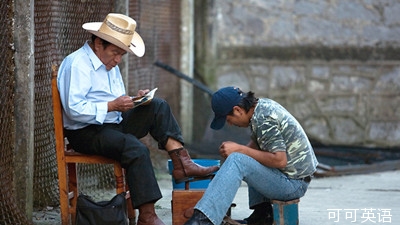财经商业
Defining class in Mexico
墨西哥阶层划定
Middle worth
中产阶级的价值
Politicians and statisticians hunt for the middle class
政治家和统计员们寻找中产阶级
IN THE hallowed name of the middle class, Mexico's politicians have been doing a lot of huffing and puffing lately.
在中产阶级的神圣名义下,墨西哥的政治家最近一直在进行大量愤怒抨击。
The source of their indignation is the president's plan to raise income tax on annual salaries over 500,000 pesos and impose value-added tax on private schooling and mortgage payments.
他们愤怒的起因是总统对年工资收入超过500,000比索的人提高所得税和对私人学校和抵押贷款征收增值税的计划。
That, the people's representatives complain, would beat the stuffing out of ordinary, hard-working families, so they plan to spare them the tax on schooling and housing.
这样的话,人民的代表们抱怨道,会使普通的,努力工作的家庭一蹶不振,所以他们打算帮他们在教育和房贷方面减轻税务负担。
If only the middle class were so lucky.
如果中产阶级有这么幸运的话。
 According to measurements by the national statistics institute, most of its members earn nowhere near the 500,000-peso threshold, let alone send their children to private school or pay mortgages.
According to measurements by the national statistics institute, most of its members earn nowhere near the 500,000-peso threshold, let alone send their children to private school or pay mortgages.
根据国家统计局的测量,它的大部分成员每年赚的远远不到500,000门槛,更不用说送他们的孩子去私人学校或者支付抵押贷款了。
Defining the middle class in Mexico has become a subject of fierce debate since two pundits, Luis de la Calle and Luis Rubio, published a book last year called Mexico: A Middle Class Society.
明确在墨西哥的中产阶级成为激烈辩论的一个话题,自从两个学者,Luis de Ia Calle and Luis Rubio,去年出版了一本名为墨西哥:一个中产阶级社会。
Poor No More, Developed Not Yet.
不再贫穷,尚未发达。
It claimed that more than half of Mexico's population had joined the bourgeoisie.
它声称超过一半的墨西哥人口已经成为了资产阶级。
INEGI's statisticians were sceptical, partly because the book used access to technology as a measure of social status.
国家统计局的统计员们对此持怀疑态度,部分是因为这本书以接触到现代科技作为社会地位的估量措施。
So the institute set out to develop a new definition, not based on any preconceptions of what a middle-class household should look like.
所以这个机构着手发展一个新的定义,不是基于任何对中产阶级的房子应该是什么样子的先入之见。
First, INEGI looked at spending rather than income.
首先,国家统计局把视线投向花费而不是收入。
It reckoned spending is less likely to be underreported in its household surveys, and may also incorporate information about savings and expected future earnings.
它认为花费更不可能在家庭调查中被低估,并且它可能还包含着储蓄和预期未来收入的信息。
Household spending, however, can be a slippery gauge of social status.
不过家庭花费可能是社会地位一个不容易捉摸的标准。
It may rise in families with many children and fall among the elderly.
它可能在孩子很多的家庭上升和老年人下降。
It can be distorted by one-off events, such as illness or funerals.
它可能被一次性的事件曲解,例如疾病或者葬礼。
So INEGI focused on 17 categories of spending that are recurrent and to some extent discretionary, such as the number of rooms in a home, or outlays on chicken, education or haircuts.
所以国家统计局集中关注17种周期性的并且在某种程度上具有任意性的花费,例如家里的房间数,或者在鸡肉上的花费,教育或者美发。
This allowed INEGI to sort households into seven groups.
这样使国家统计局将家庭分为七个种类。
It then analysed these using more typical variables, such as income per head, education, age, family size and type of work.
它接着使用更多的典型变量来分析这些家庭,如每个人头的收入,教育,年龄,家庭规模和工作类型。
The combination of the two forms of analysis allowed it to establish levels of income at which consumption patterns tend to change.
两种分析形式的结合让它能确立收入水平,在这种水平下消费模式有变化的趋势。
INEGI concluded that Mexico's middle class, at 39% of the population, was much smaller than Messrs De la Calle and Rubio had estimated, but in keeping with the estimates of institutions like the World Bank.
国家统计局总结墨西哥的中产阶级,占人口的39%,远远小于两位学者曾经估计的,而与像世界银行之类的机构估计一致。
Moreover, middle-class Mexicans are not nearly as affluent as the politicians imagine, even if they are a lot more secure than those beneath them. Annual incomes reach only about 120,000 pesos—less than a quarter of the sum needed to enter the top tax bracket.
更进一步,中产墨西哥人不是如同政治家们想象的那么富裕的,尽管他们要远远比那些在他们之下的人要安全的多。
Only 29% of the middle class have children at private school, and just 9% pay mortgages.
年度收入仅仅为120,000比索—少于进入最高税级所需要数额的四分之一。仅仅有29%的中产阶级的孩子在私人学校上学,以及9%在支付房贷。
Politicians, in contrast, earn upwards of 1m pesos a year, which makes them almost ten times wealthier than a middle-class person as defined by INEGI.
政治家们,相反,每年赚超过1百万比索,这让他们几乎比一个被国家统计局定义为中产阶级的人富有十倍。
No wonder they are out of touch.
难怪他们与现实脱节。
 According to measurements by the national statistics institute, most of its members earn nowhere near the 500,000-peso threshold, let alone send their children to private school or pay mortgages.
According to measurements by the national statistics institute, most of its members earn nowhere near the 500,000-peso threshold, let alone send their children to private school or pay mortgages.
 According to measurements by the national statistics institute, most of its members earn nowhere near the 500,000-peso threshold, let alone send their children to private school or pay mortgages.
According to measurements by the national statistics institute, most of its members earn nowhere near the 500,000-peso threshold, let alone send their children to private school or pay mortgages.